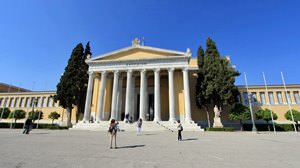Video of flights over top monuments of Athens in HD format.
Use 'Full Screen' mode.
Temple of Hephaestus, Athens
Location on the map:  Facts:
Facts:
» The Temple of Hephaestus is one of the best preserved ancient temples in Athens. It was built in 449-415 BC and was dedicated to the god Hephaestus. Hephaestus is the Greek god of fire, volcanoes and metal. » Construction of the temple of Hephaestus was begun in 449 BC.
» Temple of Hephaestus in Athens was the first temple built of marble.
» In the 7th century AD Orthodox priests converted the temple of Hephaestus to the Church of St. George.
» The length of the temple is almost 32 meters, and width is almost 14 meters. Not only all 34 columns of the Temple, but the roof has survived miraculously.
Zappeion, Athens
Location on the map:  Facts:
Facts:
» Zappeion is the building in Athens constructed in classical style by Austrian architect Theophil von Hansen. » The building is named after Evangelisa Zappasa, Greek millionaire and philanthropist that organized the first Olympia, predecessors of the modern Olympic Games.
» Construction of the building lasted for about 14 years and was completed in 1888. Consecration Zappeion was timed to the opening of the fourth Olympia in Greece.
» The building has repeatedly hosted trade fairs, exhibitions, congresses, conferences and scientific symposia, as well as music events.
» In 1896, during the first Olympic Games, Zappeion was used for sports competition; during the Olympic Games in 1906 there was the Olympic Village.
» In World War II Zappeion served as the Greek military hospital.
Church of the Holy Apostles, Athens
Location on the map:  Facts:
Facts:
» The Church of the Holy Apostles is one of the oldest Christian churches in Athens built in the 10th century. » The Church of the Holy Apostles has paramount importance as it's the only monument of the Athenian agora (town square of Athens), which remained completely in its original form.
» The Church of the Holy Apostles consists of four columns supporting the dome over the cruciform building. Apart from the main temple, the church has two of the porch completed later making the shape of the church almost U-shaped.
» The northern narthex houses a sarcophagus, where the patron of the parish was probably buried; following the Byzantine tradition he and his relatives had the right to be buried in the temple.
» Other burials were found by archaeologists in the vestibule and on the yard of the church.
Choragic Monument of Lysicrates, Athens
Location on the map:  Facts:
Facts:
» The Choragic Monument of Lysicrates is the monument erected in 334 BC close to the Acropolis. » The monument was erected by wealthy Athenian Lysicrates, who was the sponsor of many theatrical performances in the Theater of Dionysus, to commemorate the award-winning play that he had sponsored.
» The monument is mounted on a six-meter high rotunda pedestal with Corinthian columns. Above the columns there is the frieze with scene from Dionysus’s life, the transformation of the pirates who kidnapped the god into dolphins.
» The 6-meter high monument is crowned by a stone flower, on which stood a bronze tripod, an award of the theater festival of Dionysus.
» Even though the tripod was connected to the flower by bronze chains, it hasn't survived to our days.
Panathenaic Stadium, Athens
Location on the map:  Facts:
Facts:
» In ancient times, the Panathenaic Stadium was the venue for the Panathenaic Games, dedicated to the city patroness Athena. » The stadium was built of marble in 329 BC.
» A feature of this stadium is that it's the only stadium in the world built of white marble.
» The first Olympic Games were held there in 1896.
» In 2004, the Panathinaikos Stadium was one of the sites taking the Athens Olympics and was the venue for the competitions on shooting.
St. George Chapel, Athens
Location on the map:  Facts:
Facts:
» The Byzantine St. George Chapel is at the top of the Lycabettus Mountain located in the center of Athens. The mountain has a height of about 300 meters above sea level. » The Chapel was built in the 11-12th century to commemorate power of the Byzantine Empire and Christianity in that period.
» The white shrine is a small single-nave church with a dome and the bell given by Queen Olga (wife of King George of Greece I); she has taken the church under her wing.
» In 1930, the church building has been severely damaged by fire, but a year later the church was restored and reopened for parishioners.
» The church can be reached on foot or by cable car.









